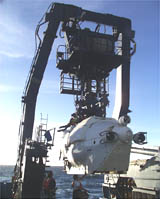

TODAY'S WEATHER
Latitude: 27deg 1’ N
Longitude: 111deg 24’ W
Wind Direction: NW
Wind Speed: 15 Knots
Sea State: 3
Swell(s) Height: 2 Feet
Sea Temperature: 67°F (19.5°C)
Barometric Pressure: 1016.6 MB
Visibility: 20 Nautical Miles
COMMENTS
- SHORT CHOP OUT OF NW
- PILOT WHALES IN THE VICINITY

BREAKFAST
Mushroom and cheddar fritatta
Organic multi-grain cereal
Cheddar cheese frittata
Scrambled eggs
Blueberry pancakes
Homefries
Sausages
Bagels
Raspberry orange drop scones
LUNCH
Cream of tomato soup
Turkey a la king with rice
Cheeseburgers
Cauliflower and Cheddar quiche
Tatertots
Assorted chocolates
DINNER
Burrito & Taco Bar
Seasoned beef & chicken fajita strips
Black beans
Refried beans
Rice
Olives, tomato, onion, lettuce
Jalapenos
Green chile
Sour cream
Salsa
Salsa verde
Black Forest cake

The
A-frame lifts Alvin off the deck. The sub weighs over 16 tons or more
than 32,000 pounds so the A-frame has to be very strong.

A
Pilot’s View of Tubeworms
Chemical
Sensor Pushed into Tubeworms

Alvin pilot
Bruce Strickrott is initiated after his first dive as a certified
pilot.
Daily Update: Dive
3516
January 13, 2000
By Dr. Dan Fornari and Dr. Susan Humphris
At 0745 hours on a beautiful sunny morning, members
of Alvin Group pulled Alvin out on to the fantail (rear deck) and
checked the electrical and hydraulic systems for the final time.
Scientists had worked throughout the night and early morning hours
loading and testing the scientific instruments they will use during
their dive to the hydrothermal vents. Meanwhile, a pod of pilot
whales circled the ship, swimming just below the surface.
At 0815 hours, with scientists Craig Cary and George Luther onboard, pilot Bruce
Strickrott guided Alvin down on the first dive of the cruise.
For pilot Bruce Strickrott, this dive had added significance.
After two years of training, Strickrott had finally become certified as a submersible
pilot. This was his first dive without another pilot present. It is a long
awaited event, and one that is celebrated in a special way. Keep reading to
find out what happened to Bruce!
The first dive marked another special event. While on the seafloor at 2,000 meters,
Craig Cary held a teleconference over a satellite link with 11 schools across
the country.
Carey talked to the students over an underwater telephone that
the Alvin pilots call the "Orca phone." Students asked questions
about life at sea, how Alvin works, and the science that we are
doing. The University of Delaware and the public television station
WHYY in Philadelphia and Wilmington arranged the teleconference.
It proved to be a fun experience for all involved.
Meanwhile back on Atlantis, scientists prepared the chemicals and equipment that
will be needed to process the samples that Alvin brings up. Other scientists
worked out in the gym or took naps in preparation for a possible long night of
processing and analyzing samples.
Unfortunately the good weather did not last. The winds picked up, gusting to
35 knots. The seas increased to two meters (6 feet). At 1330 hours, the decision
was made that Alvin should return to the surface before the weather worsened
and made recovery of the submersible too difficult.
By 1500 hours, Alvin was back onboard. The scientists
accomplished many of their objectives. They brought back tubeworms, small segmented
worms, and some flea-like crustaceans. They determined that the water temperature
around where the tubeworms lived was 30°C. They used a chemical sensor
to measure hydrogen sulfide and iron concentrations around the vents.
So what happened to Bruce? As he climbed down from Alvin, the other pilots celebrated
his first dive by throwing buckets of bright pink, soupy goo all over him. The
pilots had cooked this concoction up in the galley. Ingredients included rice,
pasta, oatmeal, and red Tang juice! No doubt the real celebration will take place
when he gets to port!
Dive Summary
Arrived on Bottom: 0929 hrs
Departed the Bottom: 1330 hrs
Maximum Depth: 2008 m
The dive accomplished several objectives, but there were also some disappointments.
The scientists located several vent sites.
Some of these areas will provide excellent for conducting chemistry
experiments and for sampling hydrothermal sediment, biology,
and microbes during the upcoming dives. They also collected several
types of worms at one of the vents.
The chemical analyzer mounted on Alvin worked well and successfully measured
iron and hydrogen sulfide concentrations in the hydrothermal fluids. Unfortunately,
the push cores used to sample the sediment got stuck in their holsters and did
not work. Some of the scientists will try to fix them tonight in time for tomorrow's
dive. The increase in the wind and waves in the afternoon prevented the pilot
and scientists from exploring more areas.
On tomorrow's dive, the scientists plan to search for more vents, collect more
samples, and begin experiments at the vents found today.
|






